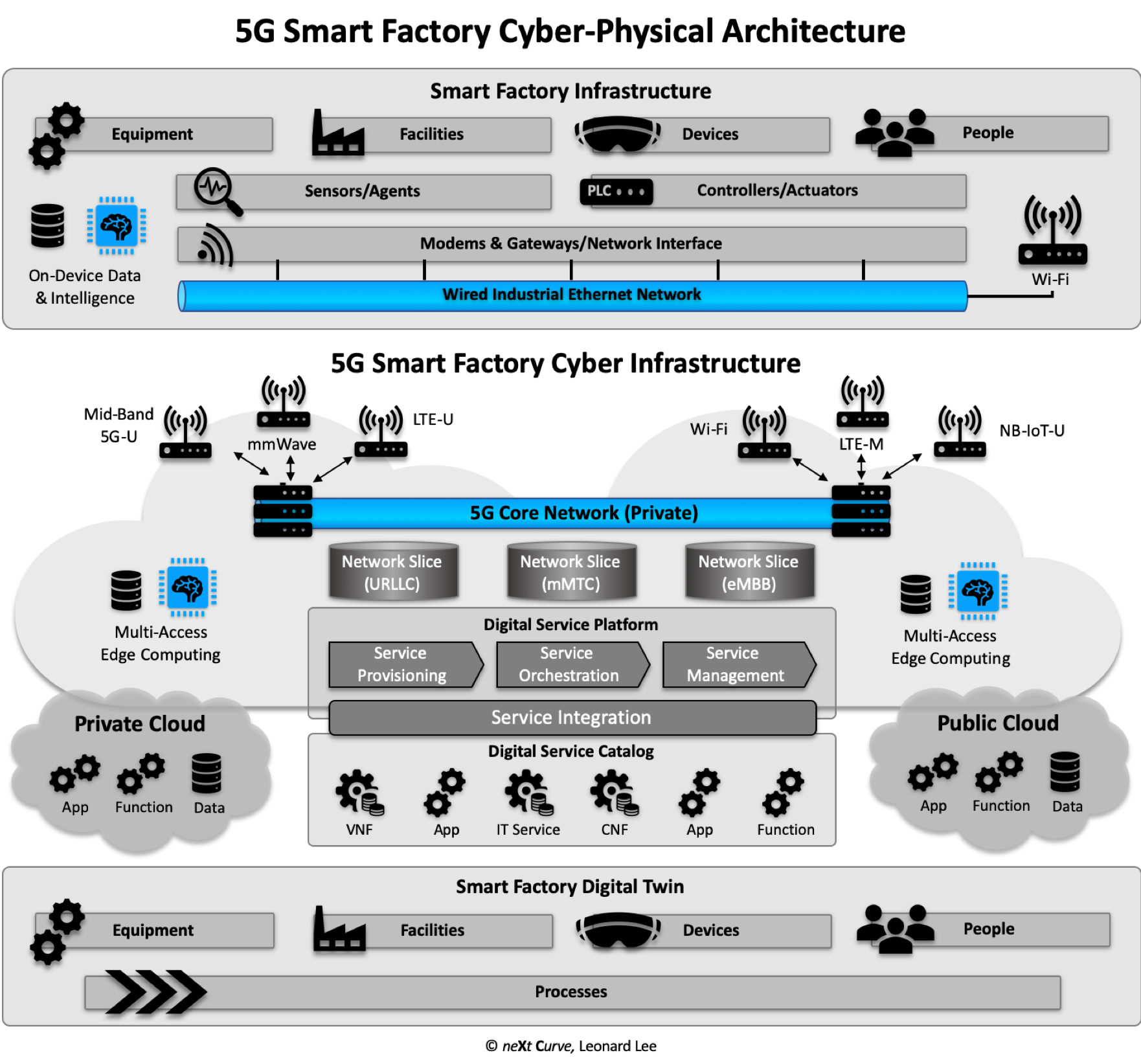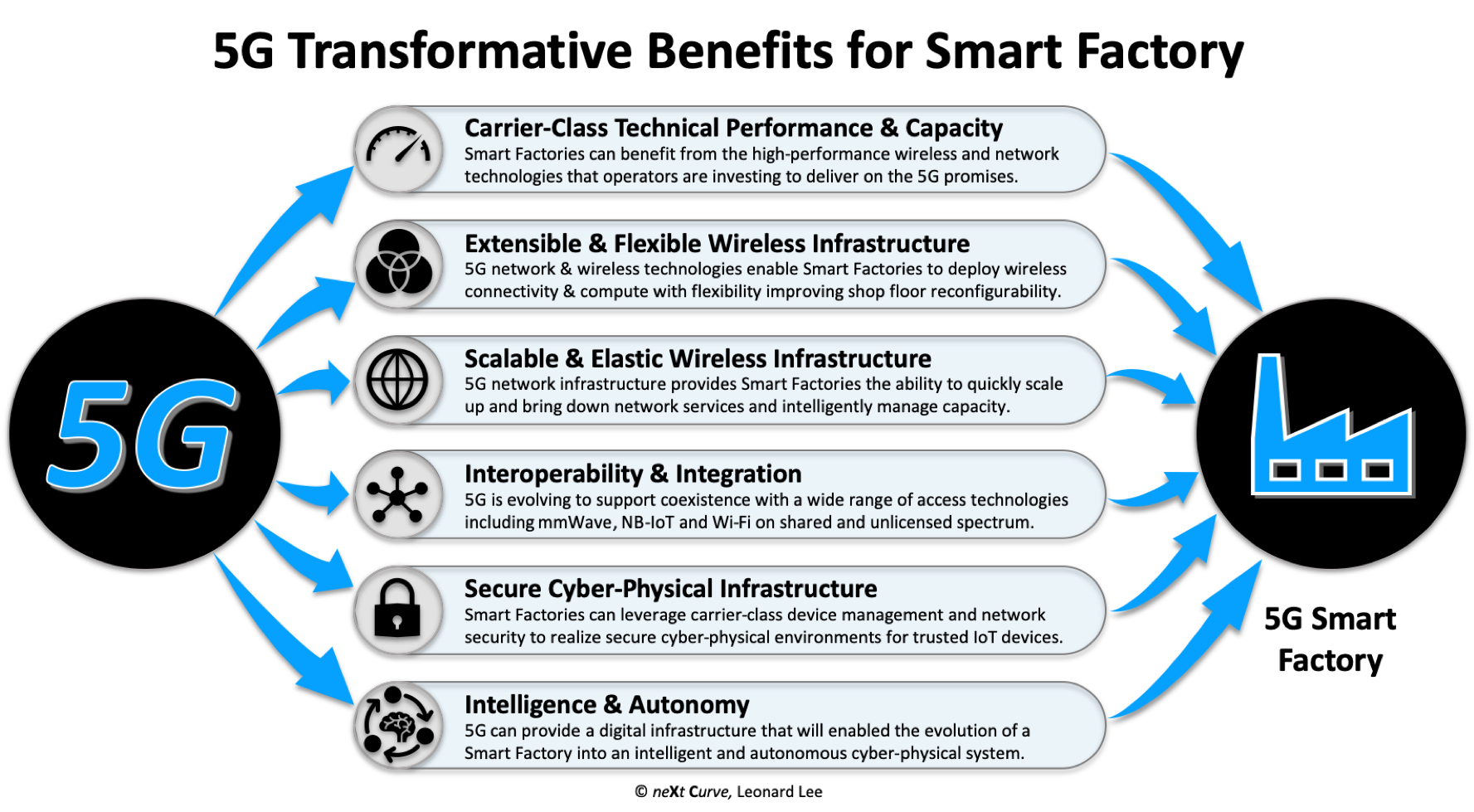As published in CIO, September 9, 2019
5G is here and there has been growing interest in what the next-generation mobile network technology means for industry. Telecom operators and industrial OT (Operational Technology) players have been investigating the use cases and potential value that the 5G promises and technology can bring to manufacturing, supply chain and the factory of the future. What does 5G mean for the Smart Factory and the way that it can operate and evolve as a cyber-physical system?
The 5G Smart Factory
5G is expected to be a critical enabler of the Smart Factory. What is the smart factory? In simple terms, it is the aspirational concept of a digitally transformed factory or warehouse. It is a cyber-physical ecosystem of virtualized and connected assets, people, and processes that constitute the manufacturing platform of the 4th industrial revolution that is Industrie 4.0.

5G is poised to bring revolutionary connectivity and communications capabilities to the Smart Factory that are expected to enable new wireless applications realized through the familiar ITU 5G use Cases:
- Ultra-Reliable Low Latency Communications (URLLC)
- Enhanced Mobile Broadband (eMBB)
- Massive Machine Type Communications (mMTC)
One of the great expectations of 5G is that it will bring a new level of flexibility to the shop floor of a Smart Factory allowing a growing number and range of mobile autonomous robots and vehicles to safely operate and coexist with humans in a manufacturing environment. 5G is also expected to enable equipment and tools to be redeployed easily and allow for the rapid and dynamic reconfiguration of production lines while maintaining industrial-grade wireless connectivity across assets and people throughout the shop floor. The net expected outcome is the transition of today’s static production models toward highly dynamic and software-defined production models.
5G: More than Just the Next-Generation Mobile Network – A Digital Reinvention
While the ITU 5G use cases promise transformative possibilities of new applications for the Smart Factory, 5G is much more. It is also much more than just a step evolution of the mobile communications technology. 5G is a revolution of wireless communications which is becoming increasingly software-defined and hyper-converged from the radio to the core network.
The virtualization of the mobile network infrastructure is opening up new possibilities for how network functions can be composed into granular, fit-for-workload services that are software-defined. Release 15 of the 3GPP 5G standard introduces Standalone (SA) 5G-NR (5G-New Radio) for the core network making a transformative 5G capability – end-to-end network slicing – possible. The entire mobile network infrastructure from the radio to the core network can be dynamically configured and deployed in new ways to deliver dedicated network services to meet various service level requirements over a common network with a high level of quality assurance.
5G is also driving the hyper-convergence of the mobile network with computing and storage with Multi-Access Edge Computing (MEC) enabling the dynamic distribution and instantiation of computing workloads such as AI and digital content rendering across the wireless network edge and on endpoint devices such as AR glasses or an IoT gateway. The digital infrastructure of a Smart Factory can take on new distributed computing architectures and deployments that can be intelligently adapted to meet rapidly changing production needs. For example, machine learning (ML) inferencing can now be deployed where it makes the most technical and economic sense across the network edge or on the endpoint device.
5G: Critical Enabler and Cyber-physical Infrastructure of the Software-Defined Smart Factory
The advent of 5G comes at a perfect time to help the Smart Factory realize new mobile wireless possibilities that will drive the next level of operational adaptability and agility. While we are familiar with 5G in the context of public mobile networks hosted by carriers, Release 16 of the 3GPP 5G standard will include support for private networks using licensed, unlicensed and shared spectrum. Why is this a big deal? It will make the bevy of 5G technologies available to manufacturers to augment their privately-operated or hosted industrial networks with carrier-class communications infrastructure, technologies and services.

While carrier-grade networks bring high reliability (99.999% availability)to the Smart Factory as a baseline, the application of Coordinated Multipoint (CoMP) with 5G-NR can realize the combination of ultra-low latency wireless connectivity (e.g. a millisecond) delivered with Six-nines (99.9999% availability) reliability across the shop floor through spatially-diverse deployments of small cells. With Time Sensitive Network (TSN) support to be introduced with Release 16 of the 3GPP 5G standard, the 5G network of the Smart Factory will deliver the performance, reliability and deterministic network communications over the air on par with wired Industrial Ethernet used to connect equipment on shop floors today. The wireless industry has already taken significant steps to make this a reality as exemplified by 5G IIoT demonstrations at this year’s Hannover Messe.
Today, factories are heterogenous, complex environments with significant technology interoperability issues that hinder operational flexibility, agility and extensibility. 5G offers standards-based technologies and digital capabilities that make the 5G network infrastructure well-suited as an extensible connectivity service bus for the Smart Factory to evolve on top of. 5G will support a wide range of interoperability features such as WiFi-coexistence, wireline and wireless convergence with support for Ethernet, and multi-access session continuity. 5G will also support various IoT communications and access protocols such as NB-IoT and LTE-M for low-power Smart Factory applications.
As the Smart Factory goes wireless and mobile, cybersecurity becomes an increasing concern as more things on the shop floor and processes become software-defined and connected over the air. 5G brings with it a robust portfolio of existing and emerging security and trust technologies to harden and secure the connected Smart Factory environment. Carrier technologies such as eSIM (embedded Subscriber Identity Module) are enabling trusted provisioning, management and monitoring of a much broader range of Industrial IoT (Internet of Things) devices on cellular networks. Furthermore, dual roots-of-trust frameworks based on Blockchain technology are emerging that will provide added security for devices on the 5G Smart Factory network as well as trusted access to digital assets on the device such as data and applications.
Implications for Business and Technology Leaders
Business and technology leaders need to recognize that the Smart Factory and Smart Warehouse are cyber-physical systems that need a carrier-class digital infrastructure that is reliable, interoperable, scalable, resilient and software-upgradeable in order to realize the Smart Factory vision of dynamic, reconfigurable shop floors and production lines only possible with wireless connectivity. Manufacturers have the opportunity to ride the 5G wave which will bring a continuous tide of telecommunications industry innovations onto the factory and warehouse floor.
For more insights on neXt Curve’s 5G Evolution & Vertical Markets research theme, contact us for a detailed briefing with one of our analysts. Follow our site to get updates and notifications of our research and our 2019 research agenda.
Related Content & Media
- Qualcomm: Bringing 5G to Industrial IoT at the Hannover Messe
- Daimler: “Factory 56”. Mercedes-Benz Cars increases flexibility and efficiency in operations
- Qualcomm: 5G Unleashes the Power of Industrial IoT
- Crossing the 5G and IoT Connectivity Chasm with SDR and SDN
- IoT Solutions World Congress 2018 – Key Takeaways
- Industrial IoT: Shaping the Future of IoT – Part 1
- Industrial IoT: Shaping the Future of IoT – Part 2
- Industrial IoT: Shaping the Future of IoT – Part 3
- Want to Get Value Out of IoT? Stop Talking About IoT
by
Leonard Lee
Managing Director, neXt Curve
September 9, 2019
This material may not be copied, reproduced, or modified in whole or in part for any purpose except with express written permission or license from an authorized representative of neXt Curve. In addition to such written permission or license to copy, reproduce, or modify this document in whole or part, an acknowledgement of the authors of the document and all applicable portions of the copyright notice must be clearly referenced.
© 2019 neXt Curve. All rights reserved.
6 comments